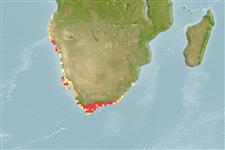Common names from other countries
>
Centrarchiformes (Basses) >
Cheilodactylidae (Morwongs)
Etymology: Cheilodactylus: Greek, cheilos = lip + Greek, daktylos = finger (Ref. 45335); referring to the fleshy lips and the lower, unbranched pectoral-fin rays (Ref. 120445).
More on author: Lacepède.
Environment: milieu / climate zone / depth range / distribution range
Ecologia
marinhas; estuarina demersal; intervalo de profundidade 1 - 120 m (Ref. 120445). Subtropical
Southeast Atlantic: Namibia to Natal, South Africa.
Tamanho / Peso / Idade
Maturity: Lm ? range ? - ? cm
Max length : 30.0 cm TL macho/indeterminado; (Ref. 9492); common length : 20.0 cm TL macho/indeterminado; (Ref. 9492)
Descrição suscinta
Chaves de identificação | Morfologia | Morfometria
Espinhos dorsais (total) : 17 - 19; Raios dorsais (total) : 23 - 25; Espinhos anais: 3; Raios anais : 9 - 11.
Mainly in shallow water among rocks, but sometimes caught down to 120 m depth. Feeds on small crabs, mollusks, worms, and other small invertebrates (Ref. 9492). Tidepools apparently an important nursery habitat for juveniles (Ref. 120445),
Ciclo de vida ou comportamento de acasalamento
Maturities | Reprodução | Spawnings | Egg(s) | Fecundities | Larvas
Smith, M.M., 1986. Cheilodactylidae. p. 667-668. In M.M. Smith and P.C. Heemstra (eds.) Smiths' sea fishes. Springer-Verlag, Berlin. (Ref. 5319)
Status na Lista Vermelha da UICN (Ref. 130435)
CITES (Ref. 128078)
Not Evaluated
Ameaça para os humanos
Harmless
Uso pelos humanos
Pescarias: pesca de subsistência
Ferramentas
Relatórios especiais
Baixar XML
Fontes da internet
Estimates based on models
Preferred temperature (Ref.
115969): 14 - 25, mean 18.2 (based on 74 cells).
Índice de diversidade filogenética (Ref.
82804): PD
50 = 0.5000 [Uniqueness, from 0.5 = low to 2.0 = high].
Bayesian length-weight: a=0.01072 (0.00482 - 0.02382), b=3.06 (2.86 - 3.26), in cm Total Length, based on LWR estimates for this (Sub)family-body shape (Ref.
93245).
Nível Trófico (Ref.
69278): 3.4 ±0.46 se; based on food items.
Fishing Vulnerability (Ref.
59153): Low vulnerability (20 of 100).
